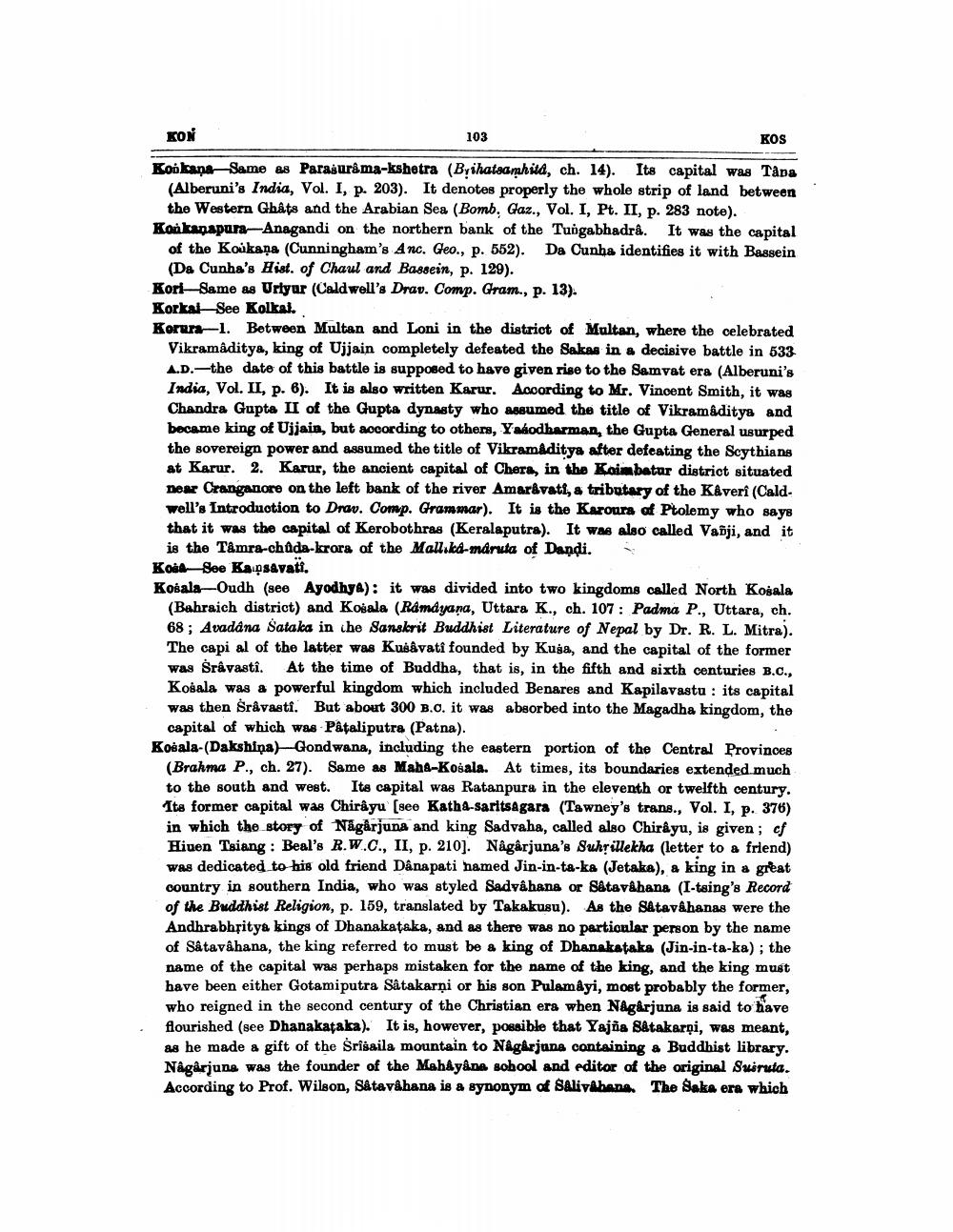________________
KON
103
KOS
Kookane Same as Parasurama-kshetra (Brihataamhita, ch. 14). Its capital was Tapa
(Alberuni's India, Vol. I, p. 203). It denotes properly the whole strip of land between
the Western Ghâts and the Arabian Sea (Bomb. Gaz., Vol. I, Pt. II, p. 283 note). Kankanapura-Anagandi on the northern bank of the Tungabhadra. It was the capital
of the Koukana (Cunningham's Anc. Geo., p. 552). Da Cunha identifies it with Bassein
(Da Cunha's Hist. of Chaul and Bassein, p. 129). Kori-Same as Urlyur (Caldwell's Drau. Comp. Gram., p. 13). Korkal See Kolkal. Koruna1. Between Multan and Loni in the district of Multan, where the celebrated
Vikramaditya, king of Ujjain completely defeated the Sakas in a decisive battle in 533 A.D.-the date of this battle is supposed to have given rise to the Samvat era (Alberuni's India, Vol. II, p. 6). It is also written Karur. According to Mr. Vincent Smith, it was Chandra Gupta II of the Gupta dynasty who assumed the title of Vikramaditys and became king of Ujjain, but according to others, Yakodharman, the Gupta General usurped the sovereign power and assumed the title of Vikramaditya after defeating the Scythians at Karur. 2. Karur, the ancient capital of Chers, in the Kaimbatur district situated Doar Cranganore on the left bank of the river Amaravati, a tributary of the Kaveri (Caldwell's Introduction to Drav. Comp. Grammar). It is the Karours of Ptolemy who says that it was the capital of Kerobothras (Keralaputra). It was also called Vabji, and it
is the Tâmra-chůda-krora of the Mall.kd-máruta of Dandi. Kos See kaupsavati. Kosala-Oudh (gee AyodhyA): it was divided into two kingdoms called North Kosala
(Bahraich district) and Koala (Ramdyana, Uttara K., ch. 107: Padma P.. Uttara, ch. 68: Avadana Sataka in the Sanskrit Buddhist Literature of Nepal by Dr. R. L. Mitra). The capi al of the latter was Kusavati founded by Kuga, and the capital of the former was Sråvasti. At the time of Buddha, that is, in the fifth and sixth centuries B.C., Kogala was a powerful kingdom which included Benares and Kapilavastu : its capital was then Srâvasti. But about 300 B.O. it was absorbed into the Magadha kingdom, the
capital of which was Pâtaliputra (Patna). Kosala-(Dakshiņa) Gondwana, including the eastern portion of the Central Provinces
(Brahma P., ch. 27). Same as Maha-Košala. At times, its boundaries extended much to the south and west. Its capital was Ratanpura in the eleventh or twelfth century. Its former capital was Chirayu (see Kath-saritsagara (Tawney's trans., Vol. I, p. 376) in which the story of Nagarjuna and king Sadvaha, called also Chirayu, is given; of Hiuen Tsiang : Beal's R.W.C., II, p. 210). Någârjuna's Sukrillekha (letter to a friend) was dedicated to his old friend Dânapati hamed Jin-in-ta-ka (Jetaka), a king in a great country in southern India, who was styled Sadyâhans or S&tavkhana (I-tsing's Record of the Buddhist Religion, p. 159, translated by Takakusu). As the Satavahanas were the Andhrabhritya kings of Dhanakataka, and as there was no particular person by the name of Såtavahana, the king referred to must be a king of Dhanakataks (Jin-in-ta-ka); the name of the capital was perhaps mistaken for the name of the king, and the king must have been either Gotamiputra Satakarņi or his son PulamAyi, most probably the former, who reigned in the second century of the Christian era when Nagarjuna is said to have flourished (see Dhanakataka). It is, however, possible that Yajna Satakarņi, was meant, as he made a gift of the Srisaila mountain to Nagarjuna containing a Buddhist library. Nagarjuna was the founder of the Mahayana sobool and editor of the original Swiruta. According to Prof. Wilson, Satavahana is a synonym of Salivahene. The Saka era which




